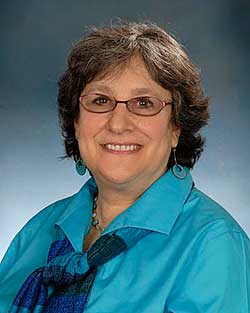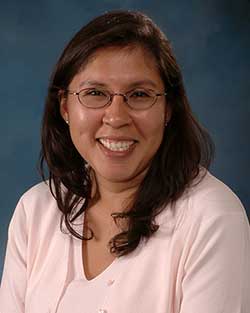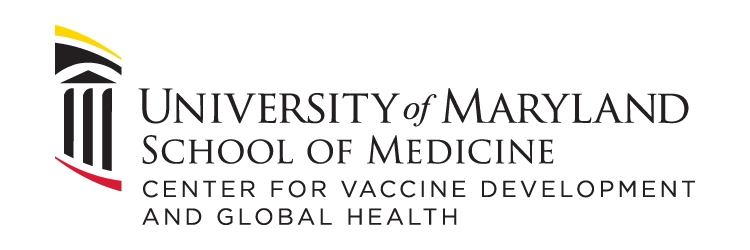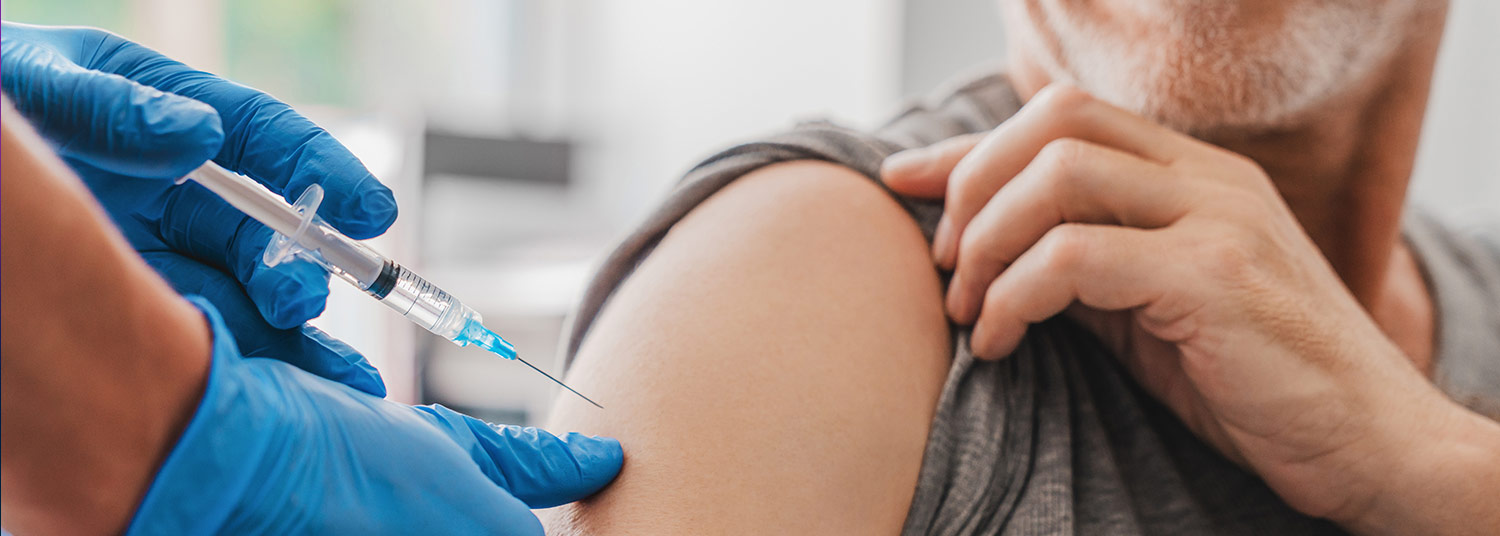July 25, 2022 | January Payne
Protein-based vaccine offers new option for primary vaccination of unvaccinated adults
The Centers for Disease Control and Prevention (CDC) this week recommended a new COVID-19 protein-based vaccine as an option for primary vaccination of adults 18 years of age and older. The University of Maryland School of Medicine’s (UMSOM) Karen Kotloff, MD, Professor of Pediatrics, Medicine, Epidemiology, and Public Health, co-led the multi-center PREVENT-19 clinical trial, which studied safety and efficacy of the Novavax vaccine in about 30,000 adult study participants.

The results of the trial, published in the New England Journal of Medicine, showed that the Novavax COVID-19 vaccine demonstrated 90.4% efficacy against COVID-19 infection and prevented 100 percent of severe disease. The trial was conducted in the United States and Mexico between Dec. 27, 2020, and Feb. 18, 2021, before the Omicron variant became dominant.
“Adults in the U.S. will now have access to a protein-based COVID-19 vaccine backed by data that has demonstrated efficacy, safety, and tolerability,” said Dr. Kotloff, who is also Head of the Division of Pediatric Infectious Disease and Associate Director of Clinical Studies at UMSOM’s Center for Vaccine Development and Global Health (CVD). “Offering more vaccine technologies and options in our vaccination portfolio, including those successfully used for years in widely available vaccines, will hopefully help increase our country’s vaccination rate. In addition, its simplified storage and transport requirements will satisfy global needs.”
In 18-to-64-year-old study participants, 57.9 percent had local reactions at the injection site after the first dose, and 78.9 percent had local reactions after the second dose. The most common reaction among study participants following vaccination was pain or tenderness. Systemic reactions, such as fatigue or malaise, were seen in 47.5 percent of participants after dose 1 and in 69.3 percent after dose 2. Fewer than 7 percent of study participants had a fever. Reactions were less common in participants 65 years and older. Most reactions were mild or moderate and resolved within a few days.
The U.S. Food and Drug Administration issued an Emergency Use Authorization (EUA) of the Novavax COVID-19 Vaccine, Adjuvanted for Individuals Aged 18 and Over on July 13. The Biden Administration said it plans to buy 3.2 million doses of the Novavax vaccine for distribution throughout the U.S.
Experts say they hope that the availability of a protein-based vaccine that uses older technology may encourage those who are not yet vaccinated to do so now. The Novavax vaccine works similarly to vaccines for HPV, shingles, diphtheria, tetanus, and pertussis.

The difference between COVID-19 vaccines that previously received emergency authorization and the newly authorized vaccine made by Maryland-based Novavax is simple: The Pfizer and Moderna mRNA vaccines prompt the person’s own cells to make spike proteins that result in an immune response. The Novavax vaccine injects the spike protein directly into the person’s body.

This research is funded by NIAID to the UMSOM at UMB, Implementing VTEU Clinical Site, Grant number UM1AI148689. CoVPN was formed by NIAID at NIH to respond to the global pandemic. Through the CoVPN, NIAID is leveraging the infectious disease expertise of its existing research networks and global partners to address the pressing need for vaccines and antibodies against SARS-CoV-2. CoVPN will work to develop and conduct studies to ensure rapid and thorough evaluation of vaccines and antibodies for the prevention of COVID-19. The CoVPN is headquartered at the Fred Hutchinson Cancer Research Center.
About the University of Maryland School of Medicine
Now in its third century, the University of Maryland School of Medicine was chartered in 1807 as the first public medical school in the United States. It continues today as one of the fastest growing, top-tier biomedical research enterprises in the world -- with 46 academic departments, centers, institutes, and programs, and a faculty of more than 3,000 physicians, scientists, and allied health professionals, including members of the National Academy of Medicine and the National Academy of Sciences, and a distinguished two-time winner of the Albert E. Lasker Award in Medical Research. With an operating budget of more than $1.3 billion, the School of Medicine works closely in partnership with the University of Maryland Medical Center and Medical System to provide research-intensive, academic, and clinically based care for nearly 2 million patients each year. The School of Medicine has nearly $600 million in extramural funding, with most of its academic departments highly ranked among all medical schools in the nation in research funding. As one of the seven professional schools that make up the University of Maryland, Baltimore campus, the School of Medicine has a total population of nearly 9,000 faculty and staff, including 2,500 students, trainees, residents, and fellows. The combined School of Medicine and Medical System (“University of Maryland Medicine”) has an annual budget of over $6 billion and an economic impact of nearly $20 billion on the state and local community. The School of Medicine, which ranks as the 8th highest among public medical schools in research productivity (according to the Association of American Medical Colleges profile) is an innovator in translational medicine, with 606 active patents and 52 start-up companies. In the latest U.S. News & World Report ranking of the Best Medical Schools, published in 2021, the UM School of Medicine is ranked #9 among the 92 public medical schools in the U.S., and in the top 15 percent (#27) of all 192 public and private U.S. medical schools. The School of Medicine works locally, nationally, and globally, with research and treatment facilities in 36 countries around the world. Visit medschool.umaryland.edu
About the University of Maryland, Baltimore (UMB), Vaccine Treatment and Evaluation Unit (VTEU)
The National Institute of Allergy and Infectious Diseases established the Vaccine and Treatment Evaluation Units (VTEUs) in 1962 as centers of excellence for conducting clinical trials to develop new and improved vaccines and therapies against infectious diseases. For more than four decades, the UMB VTEU has conducted hundreds of clinical trials. The VTEU is currently funded under Grant number UM1AI148689, and the Principal Investigator is Karen Kotloff, MD. The VTEU participates in the clinical development of vaccines that address public health needs in the U.S. and globally. A key requirement is the capability to rapidly enroll and vaccinate large numbers of volunteers into trials according to the quality standards that can support approval and licensure, which has made them a key component of the U.S. response to vaccine development for vaccines. The VTEU performs trials of vaccines and treatment that will strengthen the national stockpile of vaccines to prevent infections that could be used as a bioterrorist weapon against the U.S., such as smallpox and anthrax. We investigate new vaccines to address public health problems, such as group A strep and C. difficile vaccines, novel approaches to improve vaccine delivery, such as the FluMist nasal vaccine and the mix and match COVID vaccine approach. We conducted the first clinical study of an edible vaccine in 1998 using genetically engineered plants that contain vaccine antigens that might protect against diarrheal diseases. In keeping with our focus on bringing vaccines to underserved populations globally, we are conducting international studies for vaccines to prevent malaria, meningitis, and many others.
About the Center for Vaccine Development and Global Health
For over 40 years, researchers in the Center for Vaccine Development and Global Health have worked domestically and internationally to develop, test, and deploy vaccines to aid the world’s underserved populations. CVD is an academic enterprise engaged in the full range of infectious disease intervention from basic laboratory research through vaccine development, pre-clinical and clinical evaluation, large-scale pre-licensure field studies, and post-licensure assessments. CVD has worked to eliminate vaccine-preventable diseases. CVD has created and tested vaccines against cholera, typhoid fever, paratyphoid fever, non-typhoidal Salmonella disease, shigellosis (bacillary dysentery), Escherichia coli diarrhea, nosocomial pathogens, tularemia, influenza, malaria, and other infectious diseases. CVD’s research covers the broader goal of improving global health by conducting innovative, leading research in Baltimore and around the world. CVD researchers are developing new and improved ways to diagnose, prevent, treat, control, and eliminate diseases of global impact. Currently, these diseases include typhoid, Shigella, E. coli diarrhea, malaria, and other vaccine-preventable infectious diseases. CVD researchers have been involved in critical vaccine development for emerging pathogens such as Ebola and Zika. In addition, CVD’s work focuses on the ever-growing challenge of antimicrobial.
Contact
January Payne
Director of Public Relations
University of Maryland School of Medicine
Office of Public Affairs & Communications
c: 443-203-8183
e: january.payne@som.umaryland.edu
t: @januarypayne


